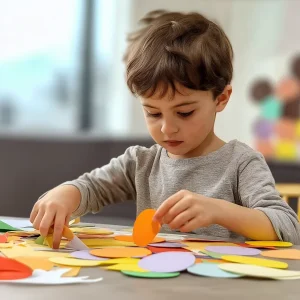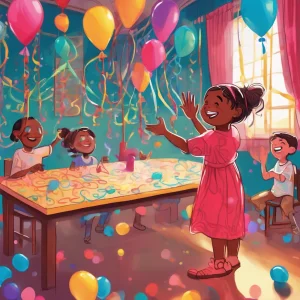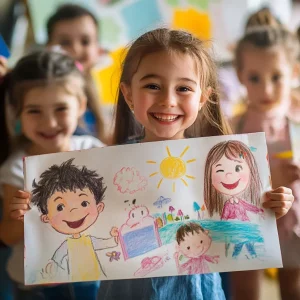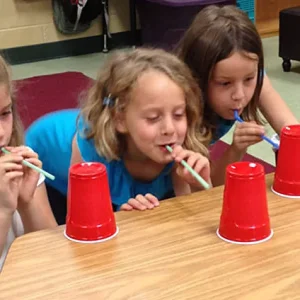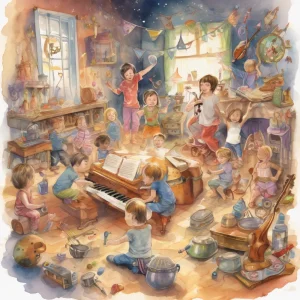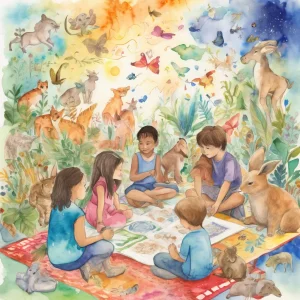Activity
Similar Activities
Ecosystem Adventure Board Game - Nature's Quest
Children’s Age: 7–9 years
Activity Duration: 10 – 25 minutes
An interactive board game where children explore and learn about ecosystems through challenges and tasks.
Activity Duration: 10 – 25 minutes
Musical Kindness Quilt
Children’s Age: 8–10 years
Activity Duration: 10 – 20 minutes
The "Musical Kindness Quilt" activity engages 9-year-old children in learning about famous musicians while enhancing communication skills and cognitive development. Children choo…
Activity Duration: 10 – 20 minutes
Enchanted Puppet Show: Creative Communication Adventure
Children’s Age: 0 month – 18 years
Activity Duration: 5 – 10 minutes
Let's have fun with the DIY Puppet Show activity! This activity helps kids improve communication skills and boosts creativity and social interaction. Gather materials like socks, g…
Activity Duration: 5 – 10 minutes
Rainbow Caterpillar Creation: A Colorful Adventure
Children’s Age: 6–10 years
Activity Duration: 10 – 20 minutes
In this fun activity called "Creating a Colorful Caterpillar," children can explore their creativity and improve their fine motor skills and understanding of sequencing. To begin, …
Activity Duration: 10 – 20 minutes
Enchanted Textures: Sensory Treasure Hunt Adventure
Children’s Age: 0 month – 6 years
Activity Duration: 5 – 10 minutes
Let's go on a Sensory Treasure Hunt adventure! We will explore different textures using our sense of touch. Gather textured items, hide them around the room, and guide the child to…
Activity Duration: 5 – 10 minutes
Magical Storytelling: Create Together with Friends
Children’s Age: 4–6 years
Activity Duration: 15 – 30 minutes
In the Create a Story Together activity, children will explore their creativity, language skills, and teamwork. Get small pieces of paper, colored pencils, and a container ready. K…
Activity Duration: 15 – 30 minutes
Whimsical Cup Blow Race for Kids
Children’s Age: 4–6 years
Activity Duration: 5 – 10 minutes
The Cup Race Challenge activity is designed to boost teamwork, fine motor skills, and problem-solving in children. You'll need plastic cups, straws, a table, and masking tape to cr…
Activity Duration: 5 – 10 minutes
Musical Journey Through Time and Space - Instrument Exploration
Children’s Age: 3–4 years
Activity Duration: 15 minutes
Embark on a creative musical journey with children aged 36 to 48 months to boost their communication, self-care, and play skills. Use household items as instruments, set up a perfo…
Activity Duration: 15 minutes
World Wonders: Around the World Adventure
Children’s Age: 10–12 years
Activity Duration: 30 – 40 minutes
Embark on the "Around the World Adventure" activity, a journey introducing children to various countries, cultures, and wildlife. This engaging experience enhances language, math, …
Activity Duration: 30 – 40 minutes
Whispers of Nature: The Nature Story Stones
Children’s Age: 3–4 years
Activity Duration: 20 minutes
The Nature Story Stones activity is designed for children aged 36 to 48 months to boost their communication abilities through nature-themed storytelling. Gather smooth stones, pain…
Activity Duration: 20 minutes
Enchanted Melodies: Interactive Baby Rhyme Time
Children’s Age: 3 – 6 months
Activity Duration: 10 minutes
Enhance your infant's communication skills with the "Interactive Baby Rhyme Time" activity designed for babies aged 3 to 6 months. Utilizing nursery rhymes and songs, this activity…
Activity Duration: 10 minutes
Empathy through Dance: Expressing Emotions Creatively
Children’s Age: 6–10 years
Activity Duration: 25 minutes
"Empathy through Dance" is an engaging activity tailored for children aged 6 to 10 to foster empathy, moral growth, and language skills. Children will express emotions through move…
Activity Duration: 25 minutes








